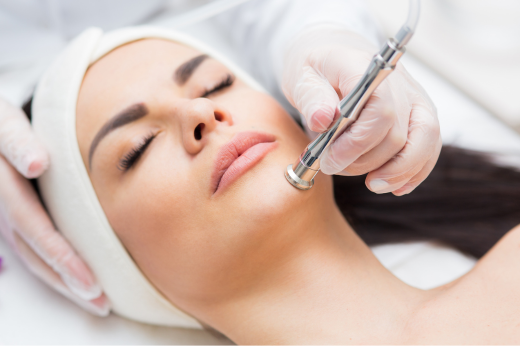
Having radiant, flawless, and glowing skin is not a dream anymore. With the advances in cosmetology, a variety of aesthetic treatments can be offered to improve your skin tone and texture. Microdermabrasion is the easiest and quickest way to improve dull skin and uneven texture. This is a popular, non-invasive cosmetic procedure (does not involve any surgical instruments, cuts, or bleeding) for treating skin imperfections like acne scars and fine lines. Microdermabrasion is an exfoliation method that scrapes off your superficial skin layer (epidermis) to reveal a healthier and more radiant layer underneath.
Keep reading to learn about microdermabrasion, including its uses, benefits, procedure, side effects, etc.
Microdermabrasion is a gentle, non-invasive, painless aesthetic procedure performed by a skilled dermatologist (a doctor who specializes in diagnosing and treating diseases and conditions related to the skin, hair, and nails). A unique device with an exfoliating tip is used to remove or scrape the skin's superficial (top) layer. This is interpreted as micro-injuries, which form new collagen (a protein that includes the building block of your skin, nails, hair, ligaments, muscles, and other connective tissues). Thus, a more radiant, flawless, and healthy skin is revealed underneath.
There are three types of microdermabrasion based on the type of device used:
Microdermabrasion is a non-invasive epidermal resurfacing procedure that helps the following skin-related concerns:
Microdermabrasion can address various skin concerns; however, it may not suit everyone. This procedure may not be effective and thus contraindicated for the following situations:
Microdermabrasion is a non-surgical, non-invasive procedure; hence, little preparation is needed. But be sure to inform the doctor about your past cosmetic surgeries, allergies, surgeries, and any underlying medical condition (if present).
Microdermabrasion is an outpatient procedure performed in the office and generally takes 30 minutes to 1 hour. Local anesthesia (a numbing agent) is not used in most cases.
The procedure is as follows:
You may require multiple sessions in specific intervals to achieve the desired results.
Not much post-procedure aftercare is involved, and you can resume your daily routine activities immediately.
Follow the steps below to maintain the effects of the result:
You may be able to see noticeable results immediately after the treatment. The number of sessions required depends on the severity of your skin condition and your expectations and will be planned and executed accordingly by your dermatologist.
Microdermabrasion is a popular cosmetic procedure that offers an array of benefits.
Microdermabrasion is a relatively safe procedure, but it may involve certain side effects which can be mild and may resolve gradually. These include:
Currently, many microdermabrasion home kits are available in the market and online. Various salons also offer this procedure. However, speaking to your dermatologist before undergoing the procedure outside a clinical setup is best. This is especially necessary to handle any complications after the procedure.
Microdermabrasion is gaining immense popularity among the female population due to its increased effectiveness in providing a spotless, glowing, and even skin tone. It has many benefits of being painless, non-invasive, and fewer side effects than other skin-related treatments.
For skin-related problems, contact your dermatologist, who can give you the kind of skin you desire.